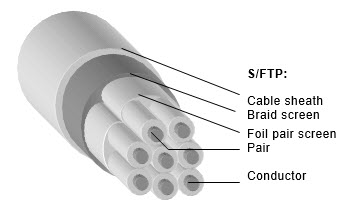1. Applicability
The following applies to balanced twisted pair copper permanent links and links of Class D to Class II cabling installations seeking performance conformance to AS 11801.1, AS 11801 series, ISO/IEC 11801 series, AS/NZS 14763.2 and/or IEC 61935-1.
2. Background
AS 11801.1 and ISO/IEC 11801-1 specifies the performance parameters and minimum values for conforming balanced cabling installations for Class D (Cat 5) to ClassII (Cat 8.2).
IEC 61935.1 specifies accuracy levels for hand-held testers and test methods to measure cabling parameters identified in AS 11801.
Customer requirements that exceed the performance conformance requirements of the above standards may also exist within the project documentation.
This Technical Note provides guidance for conducting the testing of balanced copper cabling for establishing installation performance conformance by VTI Services to meet its NATA reporting obligations against AS 11801 series and/or ISO/IEC 11801series
To conform to AS 11801 series intstallation a quality plan must be created by or on behalf of the installer in accordance with AS/NZS 14763.2
3. Testers
Testers must be fully calibrated within the period recommended by the manufacturer for all test results submitted.
Tester performance levels must be suitable for the test undertaken and support the test undertaken to the latest Standard.
The standard for testers in Australia and New Zealand is IEC 61935-1.
4. Current approved testers for compliance testing.
- Fluke DSX 5000 is approved for Class FA (Category 7A) and below, including EA (Category 6A)
- Lantek III (1000 Mhz) is approved for Class FA (Category 7A) and below, including EA (Category 6A)
- WireXpert 4500 is approved for Class FA (Category 7A) and below, including EA (Category 6A)
- Fluke DSX 8000 is approved for Class II (Category 8.2) and below, including Class I (Cat 8.1), Class FA (Cat 7A), EA (Cat 6A)
Note: 1 While other testers may be available, the compliance status of those testers would need to be established before testing.
Note: 2 The Quality plan determines what test equipment can be utilised for testing. This is typically a requirement of the specifier or the vendor
5. Firmware
The tester Firmware must be the latest published version.
- Viewing software normally allows for upgrades of firmware of testers
- Current Firmware is freely available from manufacturer’s web sites, for example:-
6. Applicable Standards
Sites shall be tested to the requirements of a current published standard and any additional customer or contract requirements using an appropriate tester.
The published balanced cabling standards for performance values include;
- ISO/IEC 11801-1
- AS 11801.1
- AS/NZS 14763.2
- ANSI/TIA 568.1-D
The published standards for balanced cabling test equipment include;
- IEC 61935-1
- ANSI/TIA 1152-A
7. Test Configuration
All tests shall be either Link, Permanent Link , Modular Plug Terminated Link (MPTL) or Channel tests.
- Permanent Link Testing is preferred by most vendors and end-users.
- A large number of customers insist on Permanent Link testing. Check before testing.
- If a warranty is to be issued, check with the cabling vendor as to which tests, testers and tester settings are acceptable for their warranty.
8. Adaptors
Approved test equipment adaptors/heads and test cables shall be used for all tests. Permanent Link Adaptors used for permanent link or link testing shall be those approved by the tester vendor or the warranty cable vendor.
- Permanent Link Adaptors shall be used for link or permanent link testing.
- Channel Adaptors shall be used for channel testing.
- A permanent link and patch cord test adaptor shall be used for MPTL testing.
- Performance Level of the tester adaptor shall equal or be greater than the performance level of the cabling system under test for links, permanent links, MPTL or channel.
9. Test Results
DOs
- Test Results shall be provided for analysis in the tester’s database format.
- Text, CSV and PDF test results are not acceptable.
- Plot data is highly regarded to aid result analysis and as visual evidence for customers.
- Test results containing Marginal/Conditional passes are considered by the standard to be a pass. VTI Services reports these as a conditional pass and may not be accepted by the Quality Plan or specifier.
- Ensure DC resistance unbalanced testing has been carried out
- For Class EA installations ensure that the installed cabling length does not fall under the minimum length specified by the Standards or the Vendor for Alien Crosstalk testing exemption
DON’Ts
- Failed or manipulated test results are deemed to be noncompliant and/or fraudulent.
- Test results not containing all the required tests are deemed to be noncompliant.
- All test results shall be free of accidental or malicious manipulation.
- Test results shall not be duplicated.
- Test data shall not be altered.
- Ensure that AC wiremap testing was NOT carried out
- Do not claim RP2 or RP3 site classification unless backed by "Complex Calculation" carried out by an Engineer
10. General Information
The term Category 5 has been adopted by Australian and New Zealand Standards as well as by the International Standard ISO/IEC 11801, instead of the American term Category 5e.
The ANSI/TIA have retained Category 5 for performance level prior to 2003. In addition, America has adopted Category 5e for post-2003 cabling performance.
To avoid confusion about which performance level is required in Australia and New Zealand, Category 5 post-2003 cable is sometimes referred to as Cat 5/5e cable.
Cat 5 (AS and ISO/IEC) is the same as Cat 5e (ANSI/TIA) in performance conformance.
- Category 5 components form Classs D links and Channels
- Category 6 components form Classs E links and Channels
- Category 6A components form Classs EA links and Channels
- Category 7 components form Classs F links and Channels
- Category 7A components form Classs FA links and Channels
- Category 8.1 components form Classs I links and Channels
- Category 8.2 components form Classs II links and Channels
VTI Services provides professional Independent Verification, Testing and Inspection of Communication Infrastructures through innovation in research, development, design and delivery of unique services and assists our clients in the protection of their investment in the Communication Infrastructure and provides credible independent expertise in Verification, Testing and Inspections.
11. General Cable Types
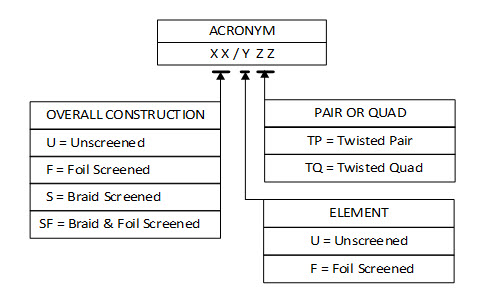
The Acronyms above define the type of cable construction.
U/UTP No screen over unscreened twisted pairs
Unscreened outer layer over UTP
Commonly called just UTP cable
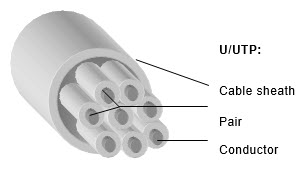
F/UTP Foil over unscreened twisted pairs
Foil outer screen layer over UTP
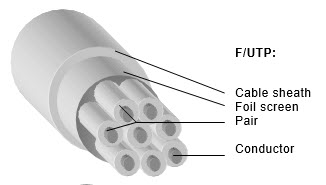
U/FTP No Screen over foil twisted pair
Each pair has a foil screen but no screen overall

F/FTP Foil Screen over foil twisted pair
Each pair has a foil screen and a foil screen overall
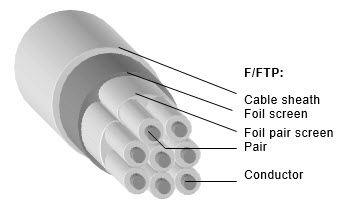
S/FTP Braid Screen over foil twisted pair
Each pair has a foil screen and a braid screen overall
(aka PiMF – pairs in metal foil)
Note: In standards, there is no such cable or acronym as “shielded cable” or STP.
